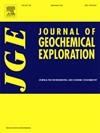大厂高峰块状碳酸盐替代型锡矿石中硫化物地球化学特征:关键金属的沉淀条件与富集
IF 3.3
2区 地球科学
Q1 GEOCHEMISTRY & GEOPHYSICS
引用次数: 0
摘要
硫化物矿体是多种关键金属的重要载体,因此,评价富硫化物矿床的找矿潜力具有重要意义。碳酸盐岩替代型锡矿(锡石-硫化物型)含锡硫化物矿通常含有大量的副产物——关键金属。采用EPMA和LA-ICP-MS分析了高峰矿床铁闪锌矿、毒砂、磁黄铁矿和詹姆士铁矿的主微量元素组成。位于油江盆地大厂矿田的高峰锡多金属矿床是典型的富硫化物碳酸盐替代型锡矿床,储量为0.23 Mt. Sn、0.65 Mt. Sb、1.5 Mt. Zn、0.79 Mt. Pb、2800 t. Ag、2000 t. in。100号矿体赋存于中泥盆统礁灰岩中,受矿后花岗斑岩岩脉侵入。硫化物占矿石的90%以上,主要有铁闪锌矿、磁黄铁矿、毒砂、詹姆士铁矿等。LA-ICP-MS分析和主成分分析(PCA)结果表明,硫化物中微量元素浓度总体表现出较强的空间一致性,与水平分布无显著相关性。硫化物中微量元素分布的空间均匀性表明,各硫化物在整个矿体中的沉淀率较高,花岗岩斑岩与未发现的成矿花岗岩基关系密切,在成矿过程中没有直接作用。铁闪锌矿的特点是可利用地富集Cd (5479 ppm)和In (604 ppm),主要的替代机制是Zn2+↔(Fe2+, Mn2+, Cd2+)和2Zn2+↔In3+ + Cu+。硫钼矿中的锡含量非常高,从222到4315 ppm不等(平均:814 ppm),其中锡通过2Sb3+ + Fe2+↔2Sn4+ +□和2Sb3+ +□↔Sn4+ + 2(Ag+, Cu+)。矿化温度为毒砂353 ~ 372℃,六方磁黄铁矿254 ~350℃,铁闪锌矿329±26℃,<;~180℃为单斜磁黄铁矿,表明流体冷却是硫化物析出的关键机制。锡石和毒砂的共沉淀可能受流体冷却和3SnCl2 + 2H3AsO3 + 2FeCl2 + 2H2S = 3SnO2 + 2FeAsS +10H+ + 10Cl−的氧化还原反应控制。高成矿温度和“铟窗”效应是碳酸盐替代型锡矿铁闪锌矿中铟富集的主要控制因素。詹姆士铁矿副产物锡的提取潜力巨大,锡可能来源于早期沉淀锡石的部分再活化。本文章由计算机程序翻译,如有差异,请以英文原文为准。
Geochemistry of sulfides from massive carbonate replacement type tin ore at Gaofeng, Dachang orefield: Insights into precipitation conditions and enrichment of critical metals
Sulfide ore minerals are significant carriers of multiple critical metals, thereby highlighting the importance of evaluating the exploration potential in sulfide-rich deposits. Tin-bearing sulfide ores from the carbonate replacement type tin deposits (cassiterite-sulfide type) generally contain substantial reserves of critical metals as by-products. This study analyzes the major and trace elements compositions of marmatite, arsenopyrite, pyrrhotite, and jamesonite from the Gaofeng deposit using EPMA and LA-ICP-MS. The Gaofeng Sn-polymetallic deposit, situated in the Dachang orefield, the Youjiang Basin, is a typical sulfide-rich carbonate replacement type tin deposit with reserves of 0.23 Mt. Sn, 0.65 Mt. Sb, 1.50 Mt. Zn, 0.79 Mt. Pb, 2800 t Ag and 2000 t In. The No. 100 ore body, hosted within Middle Devonian reef limestone, is intruded by the post-ore granite porphyry dyke. The sulfides account for over 90 wt% of the ore, mainly including marmatite, pyrrhotite, arsenopyrite, and jamesonite. LA-ICP-MS analysis and principal component analysis (PCA) results show that trace element concentrations in sulfides generally exhibit strong spatial consistency and no significant correlation with the horizontal distribution. The spatial uniformity of trace element distribution in sulfides indicates the precipitation rate of each sulfide is relatively high throughout the ore body, and the granite porphyry is closely related to the undiscovered ore-forming granite batholith without a direct role in the ore-forming process. Marmatite is characterized by exploitable enrichment of Cd (5479 ppm) and In (604 ppm), with dominant substitution mechanisms of Zn2+ ↔ (Fe2+, Mn2+, Cd2+) and 2Zn2+ ↔ In3+ + Cu+. The Sn content in jamesonite is notably high, ranging from 222 to 4315 ppm (average: 814 ppm), with Sn incorporated via 2Sb3+ + Fe2+ ↔ 2Sn4+ + □ and 2Sb3+ + □ ↔ Sn4+ + 2(Ag+, Cu+). The mineralization temperatures are estimated as 353–372 °C for arsenopyrite, 254–~350 °C for hexagonal pyrrhotite, 329 ± 26 °C for marmatite, and < ~180 °C for monoclinic pyrrhotite, indicating fluid cooling is the key precipitation mechanism for sulfides. The co-precipitation of cassiterite and arsenopyrite is likely controlled by fluid cooling and redox reaction of 3SnCl2 + 2H3AsO3 + 2FeCl2 + 2H2S = 3SnO2 + 2FeAsS +10H+ + 10Cl−. High mineralization temperature and the “indium window” effect are the dominant controls on indium enrichment in marmatite/sphalerite from carbonate replacement-type tin deposits. Jamesonite shows a tremendous potential for Sn extraction as by-product, where Sn may source from the partial reactivation of the early precipitated cassiterite.
求助全文
通过发布文献求助,成功后即可免费获取论文全文。
去求助
来源期刊

Journal of Geochemical Exploration
地学-地球化学与地球物理
CiteScore
7.40
自引率
7.70%
发文量
148
审稿时长
8.1 months
期刊介绍:
Journal of Geochemical Exploration is mostly dedicated to publication of original studies in exploration and environmental geochemistry and related topics.
Contributions considered of prevalent interest for the journal include researches based on the application of innovative methods to:
define the genesis and the evolution of mineral deposits including transfer of elements in large-scale mineralized areas.
analyze complex systems at the boundaries between bio-geochemistry, metal transport and mineral accumulation.
evaluate effects of historical mining activities on the surface environment.
trace pollutant sources and define their fate and transport models in the near-surface and surface environments involving solid, fluid and aerial matrices.
assess and quantify natural and technogenic radioactivity in the environment.
determine geochemical anomalies and set baseline reference values using compositional data analysis, multivariate statistics and geo-spatial analysis.
assess the impacts of anthropogenic contamination on ecosystems and human health at local and regional scale to prioritize and classify risks through deterministic and stochastic approaches.
Papers dedicated to the presentation of newly developed methods in analytical geochemistry to be applied in the field or in laboratory are also within the topics of interest for the journal.
 求助内容:
求助内容: 应助结果提醒方式:
应助结果提醒方式:


